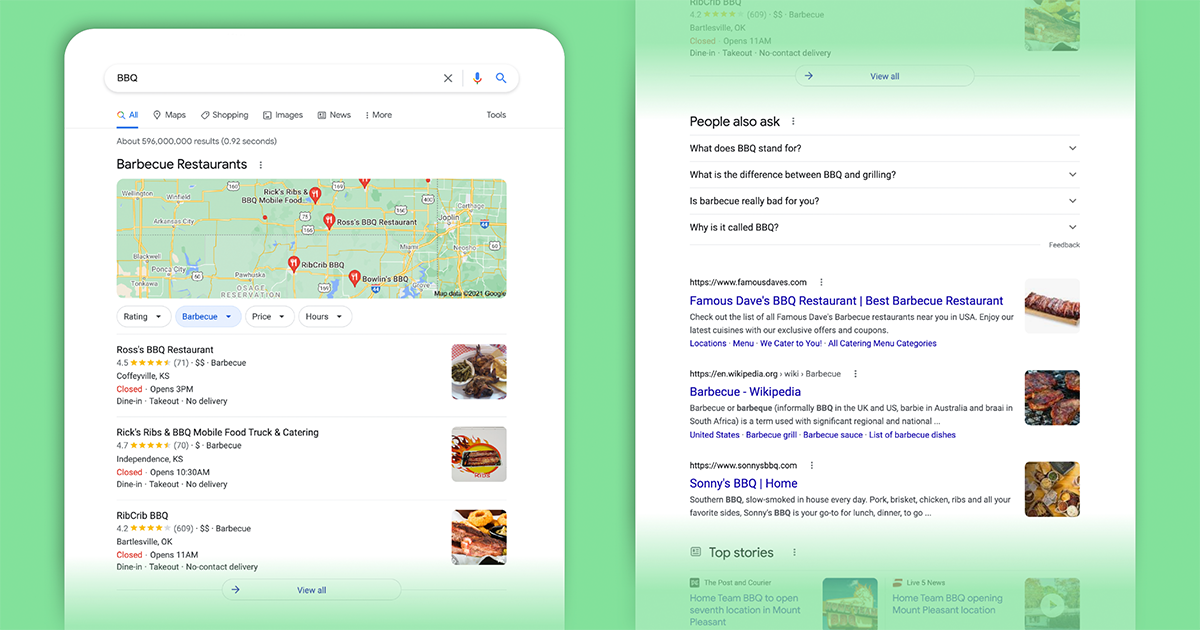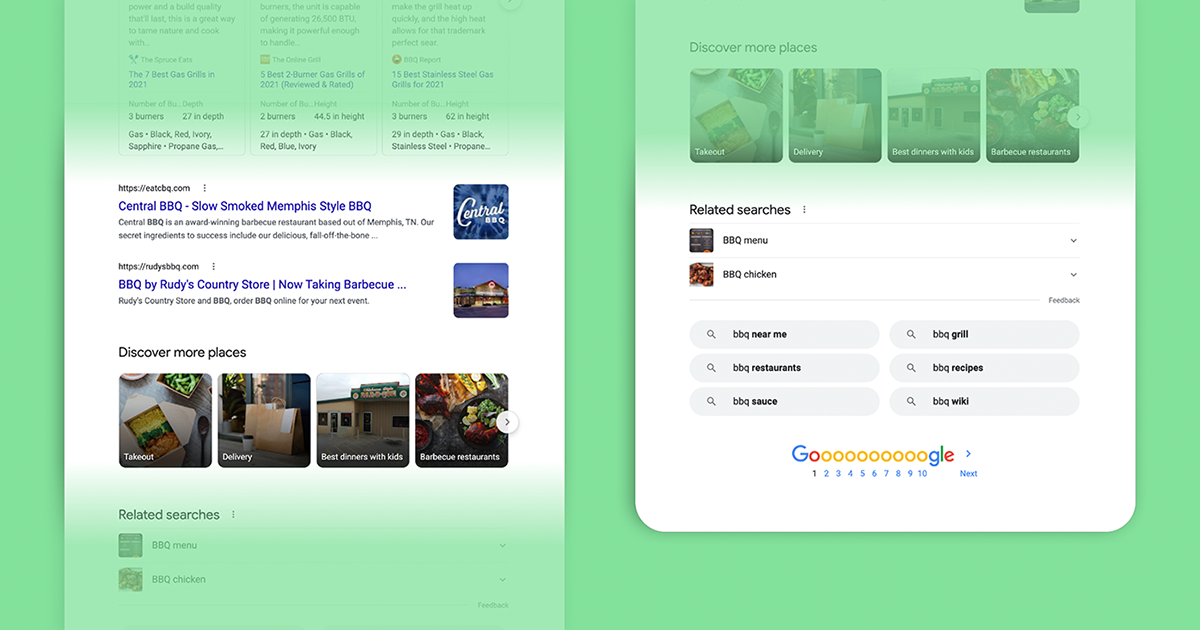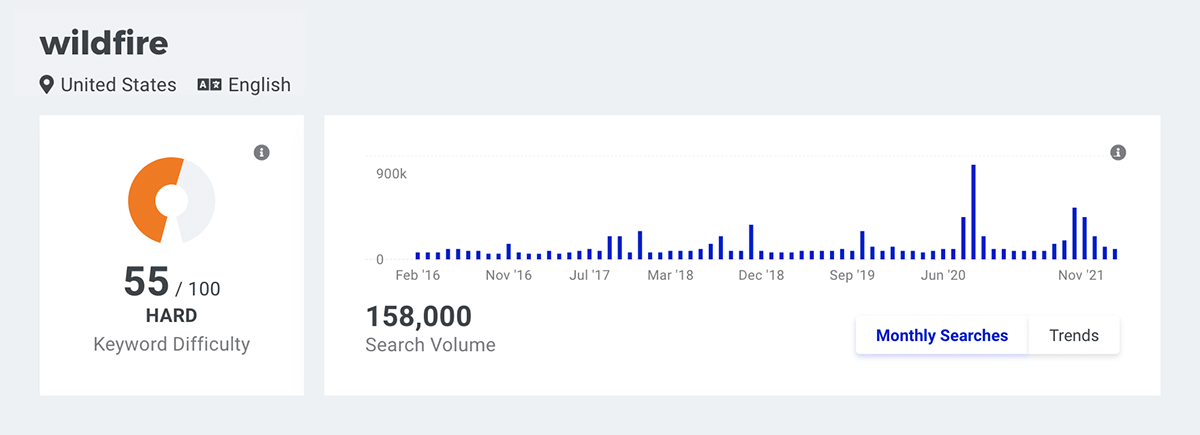SEO guide: Understanding and meeting the search intent
The term “search intent” describes the user’s intention behind their search query. For a webpage to generate organic visibility in Google, the content must be aligned with the search intent.
Example
People who search for “BBQ” usually want to be informed about barbecues, read barbecue recipes, visit a barbecue restaurant or buy a barbecue. What if Google always showed “Barbuda Codrington Airport“ in the top positions instead, which has the IATA airport code “BBQ“? This would probably frustrate most users, who are not planning a flight, and make them less likely to use Google again.
This simple example shows that it is not enough to simply place keywords on the page that you want to rank. The content orientation of the page has a considerable influence on the position in which the page will appear in search results.
The Google SERP (search engine result page) for the term BBQ is segmented as follows:

1. Google Maps / Google My Business results, 2. People also ask, 3. Organic results…

…4. Top stories, 5. Additional organic results, 6. Top 16 Outdoor Grills…

…7. Additional organic results, 8. Discover more places, 9. Related searches.
Definition
The term “search intent” (or “intent” for short) describes the user’s intention behind their search query. It is differentiated into 4 types, although the definitions are a bit fuzzy.
| Type of intent | Explanation | Examples |
| Informational (“know”) | The user is looking for information. | “search intent” “what is search intent” |
| Commercial / transactional (“do”) | The user would like to buy a product, book a service or compare suppliers. | “seo support” “best seo agency” “cloud storage” |
| Navigational (“website”) | The user is looking for a page within a particular site. | “gmail login” “svaerm local seo” “amazon prime video” |
| Local (“visit in person”) | The user is looking for something near them. | “seo agency frankfurt” “web design near me” |
Limitations of the definition of “search intent”
1. The correct terminology may not be chosen
Although local search queries are paraphrased by Google as “visit in person”, they do not always involve a visit to a particular place (e.g. “have pizza delivered”). There is also not necessarily an associated cost and commercial / transactional “do” search queries include:
- “website check”
- “install firefox”
- “meme generator”
2. In almost every search term there are a number of different types of intent
The “BBQ” example used above shows that search terms can be multidimensional in their search intent – as is the case in most searches. Leaving the airport confusion aside, there are various different types of intent mixed in here:
- Informational: find information about barbecues, read barbecue recipes
- Transactional: buy barbecues, order recipe books, interact with videos about barbecuing
- Local: visit a barbecue restaurant, have barbecued food delivered
As an SEO agency, we design our pages and those of our clients to reflect the search intent as well as the types of search intent from the Google search hit list. Otherwise, they would miss their target and the pages would not rank.
3. The distinction between search intent and user intent is unclear
There are differing views on whether or not a distinction should be made between the terms “user intent” and “search intent”.
Some sources understand user intent as the end goal that the user wants to achieve at the beginning of their search. By contrast, search intent is the intention behind the respective intermediate steps. Other sources use search intent and user intent synonymously.
We have never used the term “user intent” internally or in discussions with clients, although as an SEO agency we deal with the topic of search intent on a daily basis. Good SEO and good website navigation ensure that the user sees their entire intent met on the same website. They do not have to search for anything else during their session and reach their goal on a clear path through the content structure and internal links. The distinction between search intent and user intent is then relatively unimportant.
A brief techie digression
You may have noticed that, although we consider it to be of little relevance, we look at the distinction between the terms on our page on “Search intent”. Why is that?
In fact, this distinction is part of the search intent of users who are searching for the term “search intent”. This is clearly shown by the fact that pages that rank in Google for the search term “search intent” deal predominantly with this topic.
In other words, what we as authors find relevant is not important to Google users. At the end of the day, this guide is written for you, not for internal target groups. And that is “search intent” in action. This also illustrates that visibility in Google is not quite as straightforward as we’d like.
An extension of the definition of “search intent”
In practice, it is useful to distinguish between primary and secondary search intent:
- Primary search intent: the main intent of the user.
- Secondary search intent: further questions or ideas that arise during the search.
We will now take a look at why this extension is useful in a short case study.
Case study on search intent: “Medical-grade TPE”
Our client Kuraray is a specialty chemicals company with its roots in Japan. Kuraray wants to sell TPEs to customers in the medical and pharmaceutical industries. TPEs are raw materials used in the production of components for medical devices, shoe soles, tires, car parts and many other products.

Our keyword research has shown that “medical grade tpe” is a suitable keyword to optimize the page in question. The terminology implies that TPEs may be used in medical applications.
Search intent hierarchy analysis (more on this later) showed that the search intent looks (in simplified terms) as follows:
- Primary search intent: Find information about “medical grade tpes” (informational) with the possibility of contacting the vendor’s sales department (transactional / commercial). There is no sign here of a local search intent (finding a supplier in the vicinity).
- Secondary search intent: Confirmation that industry-standard tests have shown “medical grade tpes” to be safe and that they have certificates to show they are free from harmful substances. Comparison between “medical grade tpes” and silicone.
This is something we couldn’t have guessed. Without the results of such an analysis, all sorts of things could have gone wrong:
- Missing the primary search intent: A landing page that was too commercially oriented with too little information transfer would not rank. Multiple landing pages targeting individual towns or regions would not have been an efficient use of the budget.
- No focus on tests and certificates: Our client previously shared these on request, but did not proactively advertise them. As an SEO agency, we have never dealt with specialty chemicals before and only came to see tests and certificates as really important through analysis of the search intent.
- No focus on silicone: For industry decision makers searching for the keyword on Google, an absolutely key question is whether to opt for silicone or for “medical grade tpes”. We could have found this out through Kuraray’s sales department or through interviews with buyers. But how long would this have taken? And could they have told us that a comparison with silicone is more important to decision-makers from Google than a comparison with other materials such as PVC or latex? How could we even have discovered this issue in the first place?
This short case study shows that you cannot gain a true understanding of the search intent of users from Google on the whiteboard of a marketing department conference room. It is possible only through detailed search intent hierarchy analysis.
Determining the search intent correctly
We use search intent hierarchy analysis (SIHA) to determine the search intent. The concept is based on research undertaken by AJ Kohn and is explained in straightforward terms by Alexander Rus in his YouTube videos. svaerm has further developed the concept by conducting a very detailed competition analysis, looking for original content elements and briefing our technical editors with detailed “writing plans” so as not to leave out any important information.
The term “hierarchy” implies that there is an optimal order in which the page should serve the primary and secondary search intents of users from Google. We do not presume to identify this order ourselves, but determine it based on Google search hit lists and competitor pages.
How search intent hierarchy analysis (SIHA) works
SIHA looks at:
- The Google search hit list for the desired keyword with matching region and language settings. Page titles, meta descriptions and the anatomy of the SERP, including snippets, are examined.
- Competitor pages: In addition to a thorough content summary in bullet point format, factors such as scope, timeliness, originality, screen design, media use, backlink profile, E-A-T and onpage SEO are also considered.
- The focus is, of course, on determining the type of search intent and the primary and secondary search intent as well as establishing a content structure for the company’s own page. In addition, however, individual content elements and secondary keywords are extracted that offer further optimization potential.
The results are recorded in a writing plan as a brief for the technical editors. This plan consists of keywords, titles, key data for the meta description and Open Graph, headlines, content structure with references, content elements, specification of overall length, etc.
This SIHA framework enables the creation of content that is more complete, more up-to-date, more relevant and more effectively structured than that of the competition. A big advantage is that SEOs or content marketers who apply SIHA do not need knowledge of the (client’s) industry: By deconstructing Google search hit lists and competitor pages, you can systematically find all currently publicly available information that the Google algorithm classes as valid and relevant.
However, it is often advisable to supplement the content of the writing plan derived from the search intent hierarchy analysis with original content nuggets. Interviews with internal or external target groups are particularly suitable for obtaining original content.
Search intent: Turned on its head
The above illustration suggests that keywords are “set” and the search intent is derived from them. In practice, keyword prioritization often takes place based on performance figures, in particular: monthly search volume, keyword difficulty and PPC costs.
Depending on the particular project, however, the opposite approach is also possible:
- Determination of close-to-conversion search intents of the desired target group(s) from surveys
- Prioritization of keywords based on the conversion proximity of the search intent
- Creation of BoFu (bottom of funnel) content for long-tail keywords
- Slow widening out towards ToFu (top of funnel) and head keywords
Long-tail keywords vs. head keywords

Keywords are divided into head keywords (generic) and long-tail keywords (specific). What is generic and what is specific is decided by the number of hits in comparison with the content-related perception of the search intent. Some sectors have smaller niches than others and there is less content or demand for content. Therefore, the distinction between long-tail and head keywords cannot be based on a single quantitative threshold.
Top of Funnel (ToFu) vs. Bottom of Funnel (BoFu)
Optimizing for long-tail keywords makes sense because there are fewer competitors. This therefore increases the chances of ranking. There is often also a correlation between long-tail keywords and close-to-conversion keywords: If the user is looking for something very specific, they have already gone through the process of finding information and are about to make a purchase (BoFu / bottom of funnel). This consideration is a rule of thumb that cannot be generalized.

Bonus tips on search intent
Search intent is not a sideshow
Search engine optimization is great fun, but most SEOs pursue commercial goals for themselves and/or their clients.
Sometimes there is a conflict of interest between the requirements of Google (“this is what users want to see”) and those of the SEO’s client (“this is what users should buy”).
Companies that appear too promotional in their SEO-focused content marketing or only touch on the search intent (and actually the page is about something else entirely) seriously harm their own online visibility.
Less is sometimes more: To achieve conversion on a page with informational intent, a contact form at the side of the page or a link to a landing page might be sufficient, rather than vigorous sales communication with numerous call-to-actions.
More is sometimes more: Pages that are written in a nuanced manner may well perform better than one-sided reporting. Most products and services have their downsides and limitations, there are alternatives and competitors don’t always do everything wrong. If it is part of the search intent to investigate these points, they should definitely not be omitted or indiscriminately maligned.
Keyword details can change everything
Practical example 1: “Under the hood” (i.e. under the hood of the car, but it can also mean below the surface or behind the scenes) or “underhood” (i.e. under the hood of the car)? Underhood is better, so that Google does not mis-categorize the page as a guide to idiomatic expressions.
Practical example 2: As an SEO colleague pointed out at BrightonSEO in Autumn 2021, it may be a bad idea to optimize an e-commerce page for the keyword “black chandelier”. A song by Biffy Clyro is always going to rank ahead of the commercial results.
In order to make the right decisions in such matters of detail, all possible ways of writing keywords must be checked for their search intent.
Search intent may change over time
Before the pandemic, users in Google mainly associated the search term “mask” with cosmetic products. During the pandemic, though, it is primarily used to search for mouth and nose masks.
“Best” keywords such as “best seo agency” are initially allocated to individual providers that Google recommends on the basis of various SEO criteria. However, once comparison guides or listicles have been published (e.g. “The 10 best SEO agencies 2021”), these displace the individual providers.
The character of the intent can shift. What is commercial today may be informational tomorrow. New local providers may displace established national providers if the user signals indicate to Google that geographical proximity is important. Companies can acquire descriptive domains such as www.seo-agency.com to gain a competitive advantage in respect of related search terms (navigational search).
You therefore need to regularly check your web pages and, if necessary, re-optimize them for changes in search intent.
Query Deserves Freshness (QDF)
If Google detects a sudden increase in search volume for a particular term, the algorithm concludes it is a news-type event that is attracting major interest.
This then changes the rules of the game. Current content tends to rank ahead of older content, even if older content is more detailed or better researched etc. The search hit list then resembles a news ticker.
This is called “query deserves freshness” (QDF), i.e. the search request deserves up-to-date search results. Monitoring QDF topics is possible in Google Trends and in other analysis tools.

The development of search intent
The Google algorithm updates “Hummingbird” and “BERT” are milestones in the development of semantic searching. With each of these updates, we move further away from a purely syntactic matching of search term and keywords, and closer to matching according to search intent.
Since the announcement of Google “MUM”, it has been made public that we can expect a Google technology 1,000x more effective than BERT and that apparently works across language boundaries. The trend towards search-intent-focused semantic searching continues at full speed.
Any other questions?
We would be delighted to have a face-to-face technical discussion with you (free of charge) to explore how a search-intent-focused content marketing campaign or an SEO relaunch of your website could be performed. And for do-it-yourselfers, we can create search intent hierarchy analysis packages and also offer various consulting and monitoring services. Simply get in touch with us using the contact form or give us a call.